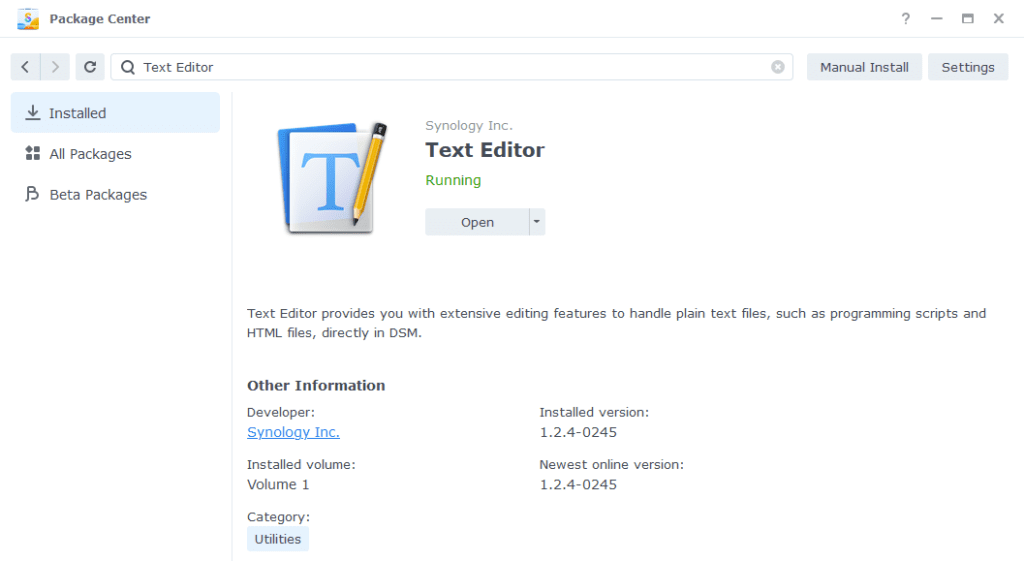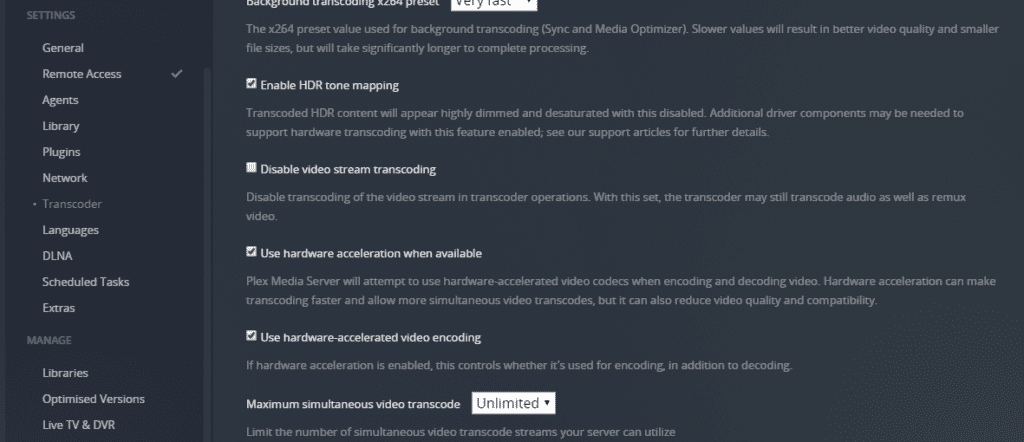Last updated on 6 April 2025
Please note if you are using DSM7.2 or higher you should use the Container Manager version of this guide from the menu.
This guide has reached the end of its updates as most people are now on the latest DSM update - This guide is correct as of 08/12/2023 however no further updates will be added.
| Update | Date |
|---|---|
| Amended the path to save the compose file – this is for security, so the container has no access to the file contents. | 14/04/2023 |
In this guide I am going to take you through the setup of Plex in Docker using Docker Compose.
As of writing the Synology UI does not have the capability of passing through specific hardware to a container, this means we will need to set up Plex via SSH (terminal). However, don’t freak out as it’s not that difficult!
Plex Pass
You will only benefit from hardware transcoding if you have an active Plex Pass either monthly or lifetime. If you don’t have one you can either follow this guide or jump over to the non hardware transcoding version.
Does my Synology support Hardware Transcoding?
Before we do anything else, you need to make sure your model of Synology has hardware transcoding capabilities. You need to do a quick lookup via the linked Google Sheet below, this is updated by Plex and makes it super easy to look up your model of NAS.
If you find that hardware transcoding is not available on your model you can jump back over to the standard guide here
Let’s Begin
As usual, it’s important you complete the two proceeding guides which will get your folder structure and docker, user setup.
Docker Compose
We will be using Docker Compose to set up the Plex container. In a nutshell we will be creating a text file (YAML formatted) which tells Docker exactly how we want to set up a specific container.
The next steps can be done either using a code/text editor such as Notepad++ or to keep things simple for this guide we will be using the Synology Text Editor which can be installed from the Package Center.

Open up Text Editor and click on File then New to start a new file.

You can now copy and paste the details below into the new text file, it is important you don’t change the spacing as YAML has to be formatted correctly in order to be read by Docker Compose.
services:
plex:
image: linuxserver/plex
container_name: plex
network_mode: host
environment:
- PUID=1234 #CHANGE_TO_YOUR_UID
- PGID=65432 #CHANGE_TO_YOUR_GID
- TZ=Europe/London #CHANGE_TO_YOUR_TZ
- VERSION=latest
- PLEX_CLAIM=
volumes:
- /volume1/docker/plex:/config
- /volume1/data/media:/data/media
devices:
- /dev/dri:/dev/dri
restart: unless-stoppedA note on Network Mode
You will notice that for Plex we don’t put it on the normal bridge network, this is because DSM reserves the DLNA ports Plex requires in order to use DLNA. So we run in Host mode, so it can share the ports.
Environment Variables
We need to make some changes in order for the container to have the correct permissions to save its configuration files and to have access to your media.
Please note the PLEX_CLAIM variable is optional and not always required. You can remove this line if you don’t need it or come back and add it if you are unable to sign in to your server on start up.
To get the code go to https://plex.tv/claim and sign in, then put the code you receive after the ‘PLEX_CLAIM=’. You have 4 mins to finish the guide after doing this, so best to grab it just before running the compose file in a few steps time.
PUID and PGID
When you created your docker user you would have noted down these IDs add these to the compose file in the ‘environment:’ section
Volumes
We can now pass through our file paths into the container they are mounted using the volume’s section of the compose file.
I have pre-filled this section to pass the correct paths, the only thing that you may need to change is the /volume1/ if your file paths are on a different volume.
Timezone
The timezone variable will tell the container where you are in the world meaning your logs and scheduled tasks will run at the correct times. A list of timezones with the correct formatting can be found here wikipedia.org/wiki/List_of_tz_database_time_zones
Your final file should look similar to the one shown below.

Saving the Compose File
We now need to save this file into our docker share.
Click on File then Save As, navigate to the ‘Docker’ share and create a new folder called ‘plex’ (lower case)

You need to change the ‘File name’ to plex.yml and save it in the ‘docker‘ folder

SSH and Docker-Compose
It’s time to get logged into your Diskstation via SSH, you can do this in the same way as when you obtained your IDs in the ‘Setting up a restricted Docker user‘ guide.

Once you have logged in you will need to give 2 commands, you can copy and paste these one at a time — you will need to enter your password for the command starting with ‘sudo’
First we are going to change directory to where the plex.yml is located, type the below and then press enter.
cd /volume1/dockerThen we are going to instruct Docker Compose to read the file we created and complete the set-up of the container. Again type the below and press enter.
sudo docker-compose -f plex.yml up -dWhen the command has completed you should be able to see Plex running in the list of containers in the Synology GUI.

Plex Initial Setup
After a few minutes you should be able to access the server and go through the Plex setup by going to the IP of your NAS in your browser followed by port 32400/web/
e.g 192.168.0.45:32400/web/
You will be asked to sign in or sign up for an account if you don’t have one already.

You should now be able to add your media which will be in the /data/media folder within Plex

Once you have got to the main Plex interface make sure you go into the settings and turn on
- Enable HDR tone mapping
- Use hardware acceleration when available

That’s it you are all setup. When a new server update is available you will just need to restart the container, and it will automatically download the latest update.
| Historic Updates | Date |
|---|---|
| New guide released | 06/12/2021 |
| Added note around Ryzen based Synology models | 27/12/2021 |
| Updated Environment Variables to ensure server is updating to the latest version | 02/02/2022 |
| Added Timezone Variable to the compose file | 22/05/2022 |
| Amended the mount path for media | 12/08/2022 |
| Amended the Plex image to pull from dockerhub to make updates easier | 18/08/2022 |
| Updated the Hardware Transcode section it’s now much easier | 02/09/2022 |
| Added the Optional Plex Claim to the Environment Variables | 18/02/2023 |
| Compose version number removed and small wording amendments | 09/04/2023 |
Looking for some help, join our Discord community
If you are struggling with any steps in the guides or looking to branch out into other containers join our Discord community!
Buy me a beverage!
If you have found my site useful please consider pinging me a tip as it helps cover the cost of running things or just lets me stay hydrated. Plus 10% goes to the devs of the apps I do guides for every year.




How to update this install?
You can update a couple of different ways, either via the DSM GUI, automate it via watchtower, or by using the docker compose, see the guides on the left menu.
If I already have plex running in docker, is there a way to keep my existing library structure or do you recommend I just bite the bullet and do it again and have plex rescan and build my library again? I had to manually match some of my older foreign shows when I switched to docker from the native app. Thanks.
You can trick plex into thinking nothing has changed other than the file path , you can do a test first… Turn off all automatic library updates and also trash removal. Add the new empty paths to each of your plex libraries.
Then move a movie over to the new structure. Do a manual library scan and it should just update that films path, keeping all the existing meta data. If that works just do the same with the rest of your files.
Happy Holidays! I am having trouble mapping to the media folder (MyMedia). It exists on volume 2. You show:
volumes:
– /volume1/docker/plex:/config
– /volume1/data/media:/media
and if I change the second line to /volume2/MyMedia then I can’t find my media files to create the plex libraries. I’m sure I don’t have the syntax right. Just to be clear MyMedia is a shared folder in volume 2 and I am trying to point to that directly. Any help would be greatly appreciated.
Hey, just amend the second line from:
– /volume1/data/media:/media
to
– /volume2/MyMedia:/media
You will need to ensure the docker user you created has been granted permission to your other share (do this in the user settings or shared folder settings)
Suppose I have two separate folders of media files. Could I add the following?
– /volume1/docker/plex:/config
– /volume1/data/media1:/media
– /volume1/data/media2:/media
Some users on Plex have access to media1 folder and other have access to both media1 and media2.
This could cause issues if you have subfolders in media 1 and media 2 with the same names.
You can just amend the mount points as ultimately plex doesn’t know anything about your data structure below them.
– /volume1/docker/plex:/config
– /volume1/data/media1:/media1
– /volume1/data/media2:/media2
Thanks. That makes total sense.
Migrating from an old dell box used as server to Synology and I want to try to preserve some of the configuration/settings. But I suspect I’ll end up just copying media and rebuilding the libraries fresh.
That did the trick! And the tip about checking permissions was spot on too. I bought you some coffee – thanks again.
Question: I wonder if this should be referencing the official Plex docker DMS7 image rather than linuxserver?
Just a question to check if it’s possible or not; I have a new DS1821+ and it’s running the Ryzen 1500B CPU instead of the Intel Celeron. Do you know if Ryzen have the hardware transcoding option or should I just go with the non hardware transcoding setup?
Hey the Ryzen doesn’t have any graphics on board so you can do the non hardware transcoding guide.
Also how you finding the 1821+ have you done a ram upgrade? I am thinking of selling my 1815+ and upgrading
Yes so far it is working like a charm. The only thing I have not been able to get working on it is Home Assistant with Z-Wave and Conbee (Zigbee), there are issues with mapping the USB to serial ports, and I ended up setting up a NUC with Unraid on it just for the Home Assistant setup. I did upgrade the NAS to 32GB non-ECC RAM and it’s working perfectly so far. Moved about 10 TB of data now, and the old one is being replaced fully later today when the rest of the setup is completed.
It seems Ryzen does not have that ability, so it answered my question quickly.